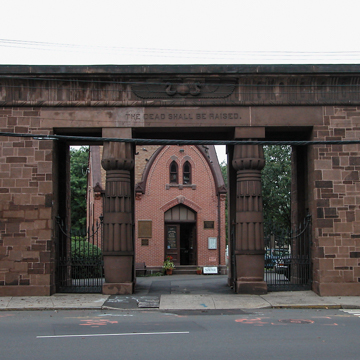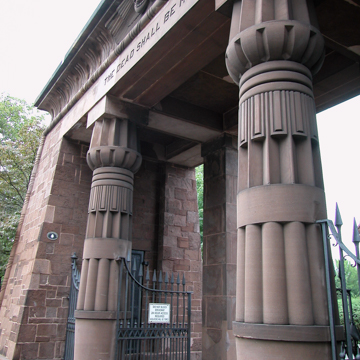The Egyptian Revival gate designed by New Haven architect Henry Austin in 1845 marks the main entrance to the Grove Street Cemetery. The burial ground itself dates back to 1796 and is the final resting place for many prominent Americans, including statesman Roger Sherman, inventors Eli Whitney and Charles Goodyear, lexicographer Noah Webster, architect Ithiel Town, and Henry Austin himself. Austin’s use of the Egyptian Revival was deemed appropriate for its funerary associations and the gate stands as one of the leading examples of the style in the United States.
Before Grove Street Cemetery was established, city residents were buried on the New Haven Green, but by the late eighteenth century, this burial ground had reached capacity. Connecticut Senator James Hillhouse proposed a new cemetery to be located northwest of the Green and to be carefully divided into numbered family plots. The Grove Street Cemetery may be one of the first in the country—if not the first—with such a layout, setting a precedent for the subsequent platting of cemeteries in the United States.
In the middle of the nineteenth century, due to security concerns, the cemetery was secured with a surrounding wall and a new gateway on Grove Street, to the west of the original entrance. The new entrance was situated at the newly opened High Street, acting both as a terminus for the street and monumental gateway into the cemetery behind it. In 1839, the committee responsible for the new plans, which included Ithiel Town, Henry Austin, and sculptor Hezekiah Augur, settled on the Egyptian Revival as the preferred style, which was popular for funerary architecture at the time. Five years later, the committee accepted Austin’s final plans, and the gateway’s cornerstone was laid on July 18, 1845. Augur was likely responsible for the surrounding eight-foot-high wall, most of which had been completed by this point. The Grove Street Cemetery Gate is the only purely Egyptian Revival structure in Austin’s oeuvre. It is conceivable that he took inspiration from publications documenting Vivant Denon’s Egyptian excursions. Richard G. Carrott noted the similarities between Austin’s design and Denon’s drawings of the Temple of Khnum at Esna and the Temple at Hermopolis Magna.
The Grove Street Cemetery Gate is approximately 48 feet wide by 25 feet high and built of red sandstone. Two massive, battered pylons, framed with a carved torus molding and topped by a cavetto cornice, give the gate its monumental appearance. They are constructed of irregularly stacked ashlar masonry and this non-regularized approach is also reflected in the varying surface treatment of the individual stones. Inside each pylon is a small room closed off by a cast-iron door. Austin placed four uprights between the pylons—two undecorated square piers face the cemetery; two round, intricately carved columns face the street. Vincent Scully describes the “machined quality” of Austin’s Egyptian Revival columns, “where the papyrus capitals are not soft and swelling, with rounded profiles, but hard, flat-planed, and edged like gears.” Between the columns and piers is a cast iron gate that can be closed to secure the entrance. The pylon lintel bears a biblical inscription: “The Dead Shall Be Raised.” This quote from 1 Corinthians 15:52 gives a Christian gloss to what would have been regarded as a “pagan” form at the time of the gate’s construction. In the center above the inscription is a winged orb flanked by two uraei. These stylized, upright portrayals of cobras were often used as symbols of sovereignty and divine authority in ancient Egypt.
With the Grove Street Cemetery now in its third century, Austin’s gate remains a dignified portal to an active burial site.
References
Brown, Elizabeth Mills. New Haven: A Guide to Architecture and Urban Design. New Haven: Yale University Press, 1976.
Cartott, Richard G. The Egyptian Revival. Berkeley: University of California Press, 1978.
Curl, James Stevens. Egyptomania: The Egyptian Revival: a Recurring Theme in the History of Taste. New York: Manchester University Press, 1994.
Faude, Wilson H. Hidden History of Connecticut. Charleston, SC: The History Press, 2010.
Kidder Smith, G.E. Sourcebook of American Architecture.New York: Princeton Architectural Press, 1996.
O’Gorman, James F. Henry Austin: In Every Variety of Architectural Style. Middletown, CT: Wesleyan University Press, 2008.
Pinnell, Patrick L. The Campus Guide: Yale University. New York: Princeton Architectural Press, 1999.
Scully, Vincent. American Architecture and Urbanism. New York and London: Frederick A. Preager, Inc., Publishers, 1969.
“The Grove Street Cemetery.” Grove Street Cemetery. Accessed May 9, 2017. www.grovestreetcemetery.org.

















